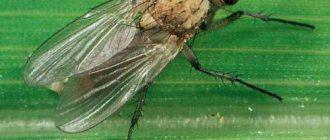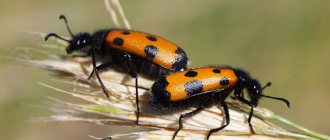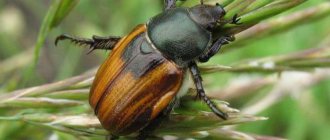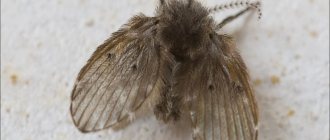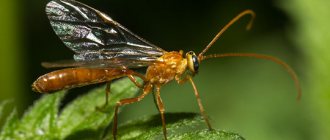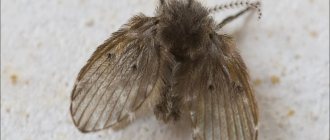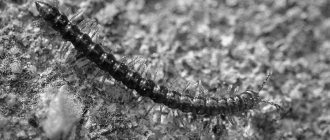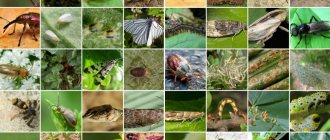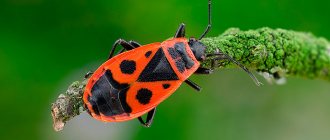Onions are present in the diet of almost every Russian. Even the smallest summer cottage must have a place for an onion bed.
However, this is the simplest crop in terms of agricultural technology. When growing onions, gardeners often encounter diseases and pest infestations. Insects cause damage to the crop or completely destroy it. In this article we will talk about pests of onions and ways to combat them.
Aphid
Aphids are a common pest that plagues onion beds. The pest is characterized by an ovoid body with a brown color, brown-black eyes, and developed antennal tubercles converging in front. It has 6 segments of the same color as the body of the insect. The larvae are dark yellow or green in color.
An onion planting affected by aphids is determined by a number of signs:
- growth retardation;
- withering and curvature of sheets;
- presence of aphid feces on feathers.
The parasite usually lives on foliage, hiding under the outer shell of the onion.
Competent agricultural technology will help protect vegetation from harmful insects:
- the day before planting, the onions are soaked in hot water;
- “underdog” is not stored together with the main harvest;
- remove weeds in a timely manner;
- Experienced gardeners recommend treating plants damaged by aphid attacks with an infusion of an insecticidal crop such as garlic (pesticides are not used if onions are grown for plumes).
Symptoms of pest damage
Pests attack onions both during the growing season and during storage.
Symptoms:
- change in color of green feathers;
- the appearance of spots and stripes on the leaves;
- drying of feathers;
- softness of the bulbs;
- the appearance of plaque on the plant.
Yellowing and drying of feathers are also caused by other reasons. For example, acidified soil, lack of nitrogen, copper or potassium, excess moisture in the soil. If you are sure that the soil is fine and the onions are not sick, then the problem is a pest invasion.
Need to know . Onion pests pose a danger not only to onion beds, but also to related plants: garlic, tulips, daffodils, lilies.
Onion rattle
Allium rattle tends to cause focal damage to cultivated vegetation. This bug is characterized by a red body, reaching a length of 6 mm. The abdomen closer to the tip has a darker color - black. The eggs are orange in color. Their size is no more than 1 mm.
The larva is characterized by the presence of 6 legs, black dots on the sides. Its color is off-white. The head with paws is red.
The beetle gnaws out many through holes in the green parts of the plant, causing the foliage to break.
You can fight the parasite using special drugs: Proclaim or Spintor.
What to do if a worm eats an onion, how to treat it, folk remedies
The benefits of onions for the human body are undeniable.
The vegetable has a number of useful substances. People have been growing this crop in their gardens for a long time. This is an unpretentious plant that is resistant to various fungi. The onion fly and its larvae cause a lot of trouble to gardeners. When a worm eats an onion, there are several ways to treat it: folk remedies and industrial preparations can provide a positive result.
Onion cutworm
Onion cutworms are either leaf-eating or gnawing. The first variety eats tops, the second lives in garden soil and gnaws turnips, causing them to rot. Insects are active at night.
Adults have the appearance of butterflies (wingspan - 5 cm) of a brownish color with the presence of white stripes. Hemispherical eggs have a dark gray tint. It is common for one butterfly to lay up to 40 eggs. After 12 days, larvae emerge from them - green caterpillars with yellow stripes on the sides.
You can protect your vegetable planting from cutworms:
- destroying weeds;
- loosening row spacing;
- placing traps in the form of containers with water to which a little jam or beer has been added;
- treating the plantings with drugs like Decis and Arrivo;
- using biological products to destroy larvae;
- using wormwood infusion with the addition of wood ash to spray the ridges.
- carrying out deep digging of the site in the autumn season.
General recommendations for protecting onions and garlic from harmful insects
1. First of all, you need to select varieties and hybrids that match the climate and growing area. 2. Crop rotation. Onion plants can be returned to the same field no earlier than after 3-4 years. Also, onion fields should be placed away from areas where onions or garlic previously grew. 3. For growing onion vegetables, it is best to choose sunny and well-ventilated fields. 4. Do not thicken crops or over-water, as this can serve as a favorable environment for insects. 5. Early sowing. The older the plants are by the time the harmful insects return, the less they will suffer from them. 6. Loosening row spacing during the growing season. 7. Periodic inspection of crops for the presence of pests, removal and subsequent destruction of damaged plants. 8. Destruction of plant residues after harvesting. 9. To prevent pests from getting into the storage, you need to collect onions and garlic in dry weather, dry them until the leaves completely dry out and dry upper scales form.
Recommendations for protecting onions from pests and diseases
Onion moth
The onion moth is characterized by the appearance of a small brown butterfly. The larvae are yellowish-green caterpillars with a fleecy body covering. At the beginning of summer, the butterfly lays eggs. They can be found on the back of the leaves, as well as on the bulbs and flower shoots.
Moths cause serious damage to onion beds. The larvae feed on the pulp of the leaves, leaving the surface of the skin untouched. Caterpillars tend to penetrate the bulb. They also harm the inflorescences. The parasite significantly reduces crop yield.
You can fight the scourge using the insecticide Iskra, as well as drugs like Dachnik and Metaphos. They are used following the instructions. Folk recipes such as garlic and tobacco infusions also help against onion moths.
Ash water and soap are also effective. To obtain it, pour boiling water over 300 g of ash. Infuse, filter and add 40 g of soap (preferably liquid).
Summer residents recommend treating plantings affected by onion moths with tincture of red pepper in pods. To prepare it, pour chopped pepper (1 kg) with water (10 l). Place on fire and let it boil. After cooling, strain. On the eve of spraying, the resulting concentrate is diluted with water (130 g per 10 l) and soap shavings (40 g) are added to the resulting liquid.
Preventive treatment with folk remedies is carried out in the spring and periodically (once every 7 days) after planting the vegetable on the ridges. The use of mulch (peat, small pine or spruce branches, rotted manure) is also recommended.
Remember
- Properly care for onions . This will reduce the risk of pests.
- Inspect plants periodically . If you notice the appearance of pests right away, it will be easier to exterminate them.
- Get rid of pests immediately. As soon as you notice insects, start treating the plant, then it may be too late.
- Use traditional methods. They will not harm you or the plants. Use insecticides only in difficult cases when colonies of pests have spread throughout the garden.
- Carry out prevention. To avoid pests, take preventive measures.
hoverfly
The onion hoverfly tends to cause serious damage to onion plantings. The parasite is widespread in the Russian Federation. It is not found only in Eastern Siberia and the Far East. Visually, the hoverfly is similar to a greenish-bronze fly (length no more than 10 mm). The larva resembles a worm, the greenish-gray body of which is covered with short spines.
Adult flights are observed in June. They lay eggs, which can be found between the dry scales of turnips. After 7 days, larvae emerge from the eggs.
Planting that suffers from attacks by insect pests is susceptible to rotting, fungal and bacterial infections. It is determined by characteristics, including:
- slow growth;
- yellowed tips of leaves;
- wilted green mass;
- softening of turnips, blackening of the core;
- unpleasant smell of rotting heads.
You can fight the parasite by using insecticides. The problem can be prevented by alternating crops, deep digging of the soil in autumn, and using bait in the form of lumps of oatmeal. Watering with saline solution (200 g per 10 l) also helps. The first time it is used to irrigate the planting when the feathers reach a height of 5 cm. The second treatment is carried out after 3 weeks.
Gray neck rot of onions
Gray neck rot of onions
The causative agent of the disease is a fungus. Infection of the bulbs occurs in the beds shortly before harvesting, and the disease manifests itself during storage of the onions.
The spores of the fungus, falling on the lower dying leaves, germinate, and the mycelium penetrates the neck of the bulb. The presence of wounds on the leaves promotes infection. Later, during storage, the tissue in the neck of the bulb decomposes and emits an unpleasant odor. The scales of the bulb are covered with gray mold with small black granular sclerotia. The mycelium spreads throughout the bulb. The affected bulb shrinks. In storage, rot moves from diseased bulbs to healthy ones. High humidity and temperature during storage are favorable for the development of the fungus. The spread of the disease is facilitated by onion mites, which cause wounds to the bulbs. When infected bulbs are planted, diseased, pale yellow plants grow and soon die.
Sources of infection are landing! material and plant remains.
Measures to combat gray neck rot of onions
- Compliance with crop rotation with the return of onions to their original place no earlier than after 3-4 years.
- Careful collection and removal of plant residues from the garden.
- Deep digging of the soil in the fall with embedding of plant remains.
- Selection of healthy bulbs for planting, culling and destruction of diseased ones.
- Sow seeded onions as far as possible from the onion plantings.
- Early sowing and planting of onions. Harvesting onions when the leaves have completely yellowed, drying them in the sun, and in wet weather - under a canopy for 7-10 days.
- When trimming onions, leave a neck at least 3-4 cm long. Place well-dried onions with dried roots for storage. The best storage conditions for onions are air humidity 70-75% and temperature +1... +2' C.
- Periodic sorting of onions during storage, removing diseased bulbs.
Stem nematode
The most dangerous enemy of vegetables is the stem nematode. Infestation by the pest threatens crop loss. The parasite has the appearance of a miniature thread-like worm (1.5 mm) with a body tapering towards the ends. The nematode sucks juices from vegetation using a needle-shaped stylet in the oral cavity. Her eggs are not visible to the naked eye.
The parasite is active in humid environments. Larvae and adults spoil foliage and turnips. You can identify a planting affected by a nematode by:
- lethargic appearance of the plant;
- thinned areas in affected areas;
- white and brownish spots on onions;
- loose turnips with scales loosely adjacent to each other;
- cracking of heads;
- rotting of the plant or its drying out.
Peak nematode activity occurs in mid-summer. It's difficult to fight her. Agents that destroy the parasite are toxic to the crop.
You can prevent the occurrence of a misfortune by taking preventive measures:
- rotation of crops on the site;
- careful selection of spoiled seed before planting;
- soaking the seeds in hot water (+55 °C) for 15 minutes;
- regular loosening of the soil;
- introducing contact poisons in a minimum dosage on the eve of planting the vegetable.
Useful tips
In the fight, all means are good. It is better to use the listed methods in combination, but proceed to chemistry only in extreme cases. What else can be done against flying and crawling insects in onion beds:
- The fight should be waged all season long. You can’t dig up the soil in the fall and think that the problem won’t return. All known techniques should be performed as needed and in a timely manner.
- If the pest is already inside the onion, then after baiting the diseased areas should be removed, since the scale insects, having penetrated into the cavity of the feather, will not receive the required dose of poison and will develop further.
- When purchasing onion sets for planting, you should select the bulbs individually, and when you bring them home, inspect the product again and treat it.
- Insect pupae are laid in the soil to a depth of 10 cm, so loosening to this depth should be carried out several times during the season.
Onions are a very porous and juicy vegetable crop, which attracts pests. The rich nutrient substance often perishes due to the negligence of gardeners. Failure to observe crop rotation, poor-quality planting material, and unprepared soil can cause the death of the onion crop.
Onion root mite
Turnips are affected by the root mite during storage. It penetrates into the vegetable from the bottom or through damage. The head affected by it rots.
The tick is characterized by a miniature size (0.2 mm), an elongated white body with annular grooves, and 2 pairs of legs. The female lays up to 25 eggs. Warmth (above +18°C) promotes the reproduction of the pest.
The presence of a tick is determined by:
- yellowed or greened inner scales of vegetables in storage;
- yellowed and curled foliage of vegetation during the growing season;
- slow growth of culture.
You can combat the problem with preventive measures:
- complete removal of the remnants of the old harvest from storage before planting the collected bulbs;
- use of Fas sulfur bombs in storage;
- high-quality drying of the crop before storing;
- rejecting damaged turnips when sorting the crop;
- collecting heads in dry and warm weather;
- trimming feathers from collected turnips;
- treatment on the eve of planting the seed with Actellik (0.1%);
- using the drug BI-58 for sowing areas.
Fighting methods
Among the methods of controlling onion pests are folk remedies, chemical, mechanical, and agrotechnical methods. Let's look at each of these methods in more detail.
Folk remedies
Folk remedies are good because they are harmless to humans. It is with them that the fight against onion pests begins.
- Soak the sets before planting in a strong salt solution for two hours. Then the onions are thoroughly washed in clean water, changing it several times.
- Adding insect repellents to the rows. Tobacco dust and fluff lime are suitable; naphthalene mixed with sand. The soil around the garden bed is sprinkled with these products once a week.
- Treat the soil around the bulbs with a mixture of wood ash, tobacco dust and ground pepper (in a ratio of 4:1:1). For one square meter of 1 m², about 200 g of this mixture is used.
- Spraying plants with an infusion of 200 g of tobacco dust, soap and ground pepper. To prepare the solution, take 10 liters of hot water, mix with tobacco and leave for 2-3 days. Before spraying, add 1 tbsp to the mixture. l. liquid soap and 1 tsp. ground pepper. Both plants and soil are treated with the strained solution.
- Marigolds planted next to onions repel the onion fly and inhibit the proliferation of nematodes.
- When a thrips infestation is first detected, spraying with yarrow infusion is effective.
If folk remedies turn out to be ineffective or there are too many pests, they switch to using chemicals.
Chemicals
When using chemicals, consider:
- When growing onions for green feathers, they are not used.
- When processing, follow the product manufacturer's instructions.
- Pests develop immunity to drugs, so change them from time to time.
Among the chemicals used to control onion pests are “Medvetox”, “Zemlin”, “Mukhoed”. These products are applied to the surface of the soil and then loosened. Plants are also sprayed with Sochva, Iskra DE, and Fitoverm preparations.
Mechanical methods
Mechanical methods of controlling onion pests:
- protection of young crops with covering material - preventing onion flies and hoverflies from laying eggs on plants;
- mulching plantings with peat crumbs - all flies avoid peaty soils;
- covering onion plantings for the winter with spruce branches - in the spring, fallen needles will repel the onion fly;
- timely removal and burning of affected plants, weeding;
- drying and sorting onions before storing.
Agrotechnical methods
Among the agrotechnical control measures, the following are distinguished:
- removal of all plant residues from the site after harvesting;
- autumn digging of the soil, which destroys the wintering sites of pests;
- compliance with the rules of crop rotation - the place for growing onions is changed after 1-2 years;
- early planting of bulbous crops - young plants have time to get stronger by the time pests appear;
- loosening of row spacing followed by watering and fertilizing;
- removal and burning of damaged plants;
- careful selection of seed material.
Onion fly
The onion fly is similar to a regular one. The pest larva poses a threat to onion planting. The parasite emerges from hibernation on the 15th of May. At the beginning of summer it lays eggs. The larvae hatch on days 5-10 and penetrate young turnips, eating them out.
The feathers of an onion affected by six become yellow and dry out, starting from the tips. The head of the vegetable itself rots. One larva can damage an entire bed in 30 days. A month later, the larvae pupate, and a new generation of pests soon emerges.
The fight against flies begins with preventive measures. Having collected the harvest, they carefully sort it out, eliminating all spoiled vegetables. The remaining turnips are dried. Before planting in the spring, the bulbs are sorted again.
Thrips
Thrips include several species of insects of the smallest size. These pests multiply very quickly: they produce several generations in open ground and in greenhouses - up to eight generations, laying more than a hundred eggs per season.
Symptoms
These small invaders feed on plant sap, causing suffering to young shoots. As a result, plants lag behind in growth, become deformed and stop developing.
For onions, onion and tobacco thrips, which are difficult to remove, are dangerous.
Bulbs affected by thrips look wrinkled under the scales, and on top they acquire a dark brown color with a silvery tint.
Mosaic bow
Mosaic bow
The disease manifests itself during the growing season. The virus infects the leaves and inflorescences of onions.
Yellow-white or cream-colored elongated spots of diseased tissue appear on the leaves. Sometimes the leaves curl or become corrugated and may wilt and droop down.
On the seeds, in addition to the leaves, the inflorescences are affected. They become deformed, the pedicels grow of different lengths, long leaves or bulbs appear on the pedicels instead of flowers, and few or no seeds are produced.
The virus is transmitted from a diseased plant to a healthy one by aphids and mites. The virus is stored in the bulbs. Diseased bulbs have an elongated shape; when stored, they quickly germinate and rot. They are the main source of infection. Onion mosaic virus is not transmitted through seeds or through soil.
Measures to combat mosaic onions
- Getting healthy onion sets. To do this, black onions are sown in areas remote from onion plantings on turnips, from onion seeds and from places where perennial onion species grow.
- Fight against virus carriers - aphids, mites. Removal of diseased plants from onion and turnip plantings during the growing season.
